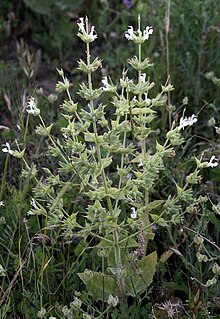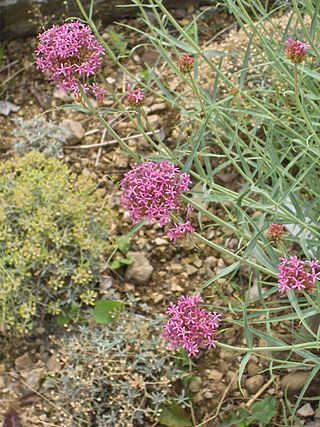
Centranthus is a flowering plant genus comprising herbs and subshrubs native to Southern Europe. It is in the family Caprifoliaceae. There are about twelve species in the genus. Some Centranthus are known as introduced species in other parts of the world, including Centranthus ruber in the western United States and Centranthus macrosiphon in Western Australia.
Medicago rotata is a species of flowering plant in the Fabaceae family. It is found throughout the eastern Mediterranean from Turkey to Israel. It forms a symbiotic relationship with the bacterium Sinorhizobium medicae, which is capable of nitrogen fixation.
Umbilicus chloranthus is a species of flowering plant in the Crassulaceae family. It is referred to by the common names green Venus' navel and ombelico di Venere verdastro. It is native to Albania, the East Aegean Islands, Greece, Turkey, and Yugoslavia.

Salvia cyanescens is a perennial shrub in the Lamiaceae family. It is native to Iran and Turkey, and was introduced to horticulture in 1959. It freely hybridizes in its native habitat with Salvia candidissima.

Salvia hierosolymitana is a species of flowering plant in the family Lamiaceae. It is a herbaceous perennial commonly called Jerusalem salvia or Jerusalem sage that is native to the eastern Mediterranean, with populations in Cyprus, Israel, Jordan, Lebanon, Syria, and the West Bank. It typically grows in open fields, rocky soils, and among low-growing native shrubs. It was first described in 1853 by botanist Pierre Edmond Boissier, with the epithet "hierosolymitana" referring to "royal, sacred Jerusalem".

Salvia judaica is a species of flowering plant in the Lamiaceae family. It is a perennial commonly called Judean sage that is native to Mediterranean woodlands and shrublands, with violet flowers blooming from April–June.
Salvia heldreichiana is species of flowering plant in the family Lamiaceae. It is a bushy perennial, endemic to Turkey and rarely seen in cultivation.
Salvia frigida is a herbaceous perennial in the family Lamiaceae. It is native to northern Iraq, northwestern Iran, and eastern Turkey growing at 900 to 2,500 m elevation. It is often found growing in Anatolia, on woodland edges, meadows, limestone slopes, and crevices. The specific epithet, frigida, refers to the cold regions where it typically grows.
Salvia freyniana is a critically endangered perennial plant that is endemic to Turkey, growing in sandy soil at 900 to 1,200 m elevation. It was first collected in 1890, described in 1892 by Joseph Friedrich Nicolaus Bornmüller and not discovered again until 2006. During field trips as part of a revision and study of Salvia species in Turkey, an unusual population of Salvia was discovered which was eventually shown to be the plant described by Bornmueller. It was the first collection of the plant since the original specimens in 1890.
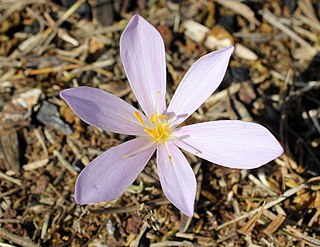
Colchicum micranthum is a species of flowering plant in the family Colchicaceae. It is native to Turkey with nearly white flowers barely 2 cm (.75") tall. It produces a series of blooms throughout the fall. The leaves follow the flowers, and are usually 3–5 in number.
Clypeola elegans is a species of flowering plant in the family Brassicaceae. It is native to Iran, Transcaucasia and Turkey.
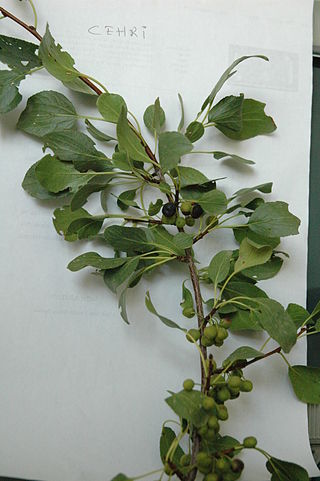
Rhamnus petiolaris is a species of flowering plant in the family Rhamnaceae. It is native to Iraq, Lebanon, Syria, and Turkey.
Salvia microstegia is a herbaceous perennial plant in the family Lamiaceae. It is native to Israel, growing on Mount Hermon. The plant has white or pale violet flowers, blooming from June to September.
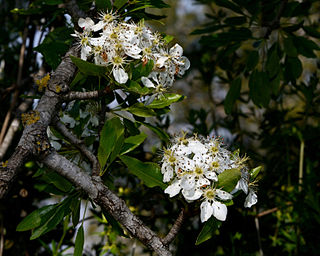
Pyrus syriaca is a deciduous tree in the Rosaceae family. It is referred to by the common name Syrian pear. It is the only pear species which grows in the wild in Lebanon, Turkey, Syria and Israel.
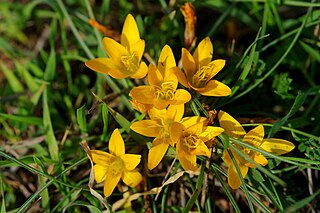
Crocus graveolens is a species of flowering plant in the family Iridaceae. It is native to Lebanon, Palestine, Syria, and Turkey.

Quercus vulcanica is a species of flowering plant in the Fagaceae family. It is referred to by the common name Kasnak oak, and is a rare species of tree native to Lebanon, Syria, and Turkey.

Acantholimon libanoticum(Lebanese prickly thrift, غملول لبناني) is a plant in the family Plumbaginaceae first described by Pierre Edmond Boissier. It is native to Western Asia from Turkey to Syria and Lebanon.

Astragalus cedreti is a species of flowering plant in the legume family. It is a perennial plant with alternating, smooth pinnate leaves and red flowers. It blooms in June.
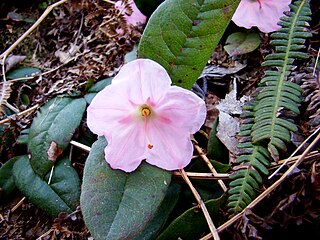
Epigaea gaultherioides is a species of flowering plant in the Ericaceae family. It is native to Transcaucasia and Turkey.
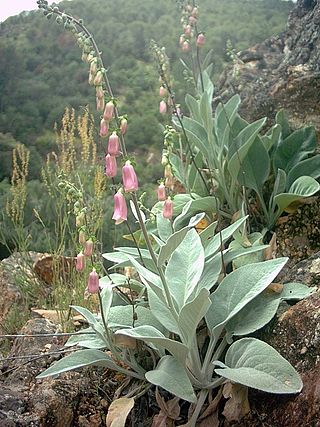
Digitalis mariana is a flowering plant species in the family Plantaginaceae. It is a perennial foxglove with evergreen foliage and rose-red coloured flowers produced in summer. It is native to Portugal and Spain.
